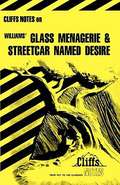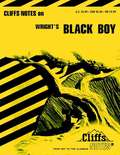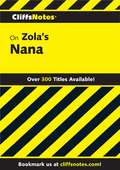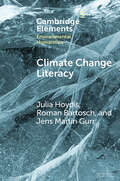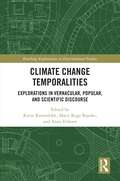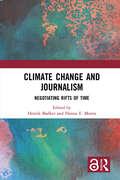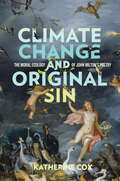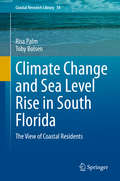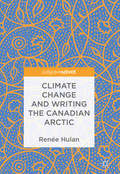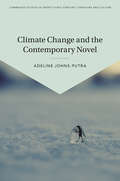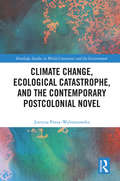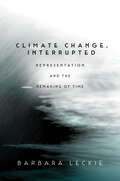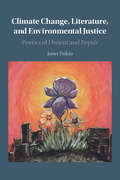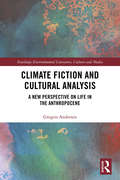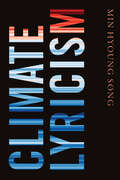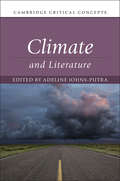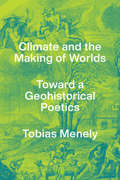- Table View
- List View
CliffsNotes on Wilder's Our Town
by Gary K CareyThis CliffsNotes guide includes everything you’ve come to expect from the trusted experts at CliffsNotes, including analysis of the most widely read literary works.
CliffsNotes on Williams' The Glass Menagerie & A Streetcar Named Desire
by James L RobertsThe original CliffsNotes study guides offer a look into key elements and ideas within classic works of literature.CliffsNotes on Glass Menagerie & Streetcar Named Desire explores two popular plays, both of which take place in the South and borrow heavily from author Tennessee Williams's own life experiences.Following stories marked by struggle among loved ones, this study guide provides summaries and critical commentaries for each scene within the works. Other features that help you figure out this important work includePersonal background on the playwrightIntroduction to and synopsis of the playsIn-depth analyses of the cast of charactersReview section that features interactive quizzes and suggested essay topicsSelected bibliographies for both playsClassic literature or modern-day treasure -- you'll understand it all with expert information and insight from CliffsNotes study guides.
CliffsNotes on Williams' The Glass Menagerie and A Streetcar Named Desire
by James L. RobertsThe original CliffsNotes study guides offer a look into key elements and ideas within classic works of literature. CliffsNotes on Glass Menagerie & Streetcar Named Desire explores two popular plays, both of which take place in the South and borrow heavily from author Tennessee Williams's own life experiences. Following stories marked by struggle among loved ones, this study guide provides summaries and critical commentaries for each scene within the works. Other features that help you figure out this important work include Personal background on the playwright Introduction to and synopsis of the plays In-depth analyses of the cast of characters Review section that features interactive quizzes and suggested essay topics Selected bibliographies for both playsClassic literature or modern-day treasure - you'll understand it all with expert information and insight from CliffsNotes study guides.
CliffsNotes on Woolf's Mrs. Dalloway
by Gary K CareyThe original CliffsNotes study guides offer expert commentary on major themes, plots, characters, literary devices, and historical background. The latest generation of titles in this series also feature glossaries and visual elements that complement the classic, familiar format.In CliffsNotes on Mrs. Dalloway, you explore one of Virginia Woolf’s greatest works, which is about life, love, friendship, and acceptance. Here, you meet Clarissa Dalloway as she’s preparing for a party she will host that evening; and Septimus Smith, a shell-shocked war veteran struggling with the aftereffects of going to battle.This study guide carefully walks you through every step of a day in the life of Clarissa and Septimus by providing summaries and critical analyses of each chapter of the novel. You'll also explore the life and background of the author, Virginia Woolf, and gain insight into how she came to write Mrs. Dalloway. Other features that help you study includeA list of charactersCharacter analyses of Clarissa and SeptimusA review section that tests your knowledgeA bibliography for more studyClassic literature or modern-day treasure—you'll understand it all with expert information and insight from CliffsNotes study guides.
CliffsNotes on Wright's Black Boy
by Carl SennaThe original CliffsNotes study guides offer expert commentary on major themes, plots, characters, literary devices, and historical background.CliffsNotes on Black Boy chronicles the alienation of the author - not only from white society, but from his own people. Richard Wright's novel is a cry of anguish in the face of the human condition and the tragedy that comes when an individual struggles to overcome it.With this study guide, you'll experience the events and the unique tone of the novel. Background about the life of the author will help shed light on the novel's themes. Other features that help you study includeCharacter analyses of major playersChapter summaries and commentariesCritical essaysCharacter genealogy chartHelpful mapsReview questions and suggested essay topicsClassic literature or modern modern-day treasure -- you'll understand it all with expert information and insight from CliffsNotes study guides.
CliffsNotes on Wright's Native Son
by Lola AmisCliffsNotes on Richard Wright's Native Son, including life and background of the author, list of characters, critical commentaries, character analyses, essay topics and review questions, and selected bibliography.
CliffsNotes on Zola's Nana
by James L RobertsThis CliffsNotes guide includes everything you’ve come to expect from the trusted experts at CliffsNotes, including analysis of the most widely read literary works.
Climate Change Denial and Public Relations: Strategic communication and interest groups in climate inaction (Routledge New Directions in PR & Communication Research)
by Núria Almiron Jordi XifraThis is the first book on climate change denial and lobbying that combines the ideology of denial and the role of anthropocentrism in the study of interest groups and communication strategy. Climate Change Denial and Public Relations: Strategic Communication and Interest Groups in Climate Inaction is a critical approach to climate change denial from a strategic communication perspective. The book aims to provide an in-depth analysis of how strategic communication by interest groups is contributing to climate change inaction. It does this from a multidisciplinary perspective that expands the usual approach of climate change denialism and introduces a critical reflection on the roots of the problem, including the ethics of the denialist ideology and the rhetoric and role of climate change advocacy. Topics addressed include the power of persuasive narratives and discourses constructed to support climate inaction by lobbies and think tanks, the dominant human supremacist view and the patriarchal roots of denialists and advocates of climate change alike, the knowledge coalitions of the climate think tank networks, the denial strategies related to climate change of the nuclear, oil, and agrifood lobbies, the role of public relations firms, the anthropocentric roots of public relations, taboo topics such as human overpopulation and meat-eating, and the technological myth. This unique volume is recommended reading for students and scholars of communication and public relations.
Climate Change Fictions: Representations of Global Warming in American Literature (Literatures, Cultures, and the Environment)
by Antonia MehnertThis book highlights the importance of the cultural sphere, and in particular literature, in response and discussion with the unprecedented phenomenon known as climate change. Antonia Mehnert turns to a set of contemporary American works of fiction, reading them as a unique response to the challenges of representing climate change. She draws on "climate change fiction"-- texts dealing explicitly with anthropogenic climate change--and explores how these works convey climate change, deal with its challenging characteristics, and with what narrative techniques they ultimately participate in its communication. Indeed, a number of challenging traits make climate change a difficult issue to engage with including its slow and long temporal dimension, global scale, scientific controversy, and its disconnect between cause and effect. Considering such complexity and uncertainty at the source of climate change fictions, this book moves beyond a solely ecocritical analysis and shows how these climate change fictions constitute an insightful cultural repertoire valuable for discussion in the environmental humanities in general.
Climate Change Literacy (Elements in Environmental Humanities)
by Jens Martin Gurr Roman Bartosch Julia HoydisThis Element presents a necessary intervention within the rapidly expanding field of research in the environmental humanities on climate change and environmental literacy. In contrast to the dominant, science-centred literacy debates, which largely ignore the unique resources of the humanities, it asks: How does literary reading contribute to climate change communication? How does this contribution relate to recent demands for environmental and related literacies? Rather than reducing the function of literature to a more pleasurable form of information transfer or its affective dimension of evoking sympathy, climate change literacy thoroughly reassesses the cognitive, affective, and pedagogic potentials of literary writing. It does so by analysing a selection of popular climate novels and by demonstrating the role of fiction in fostering a more adequate understanding of, and response to, climate change. This title is also available as Open Access on Cambridge Core.
Climate Change Temporalities: Explorations in Vernacular, Popular, and Scientific Discourse (Routledge Explorations in Environmental Studies)
by Kyrre Kverndokk, Marit Ruge Bjærke, and Anne EriksenClimate Change Temporalities explores how various timescales, timespans, intervals, rhythms, cycles, and changes in acceleration are at play in climate change discourses. It argues that nuanced, detailed, and specific understandings and concepts are required to handle the challenges of a climatically changed world, politically and socially as well as scientifically. Rather than reflecting abstractly on theories of temporality, this edited collection explores a variety of timescales and temporalities from narratives, experience, popular culture, and everyday life in addition to science and history - and the entanglements between them. The chapters are clustered into three main sections, exploring a range of genres, such as questionnaires, interviews, magazines, news media, television series, aquariums, and popular science books to critically examine how and where climate change understandings are formed. The book also includes chapters historising notions of climate and temporality by exploring scientific debates and practices. Climate Change Temporalities will be of great interest to students and scholars of humanistic climate change research, environmental humanities, studies of temporality and historicity, cultural studies, cultural history, and popular culture.
Climate Change and Journalism: Negotiating Rifts of Time
by Henrik BødkerThis edited collection addresses climate change journalism from the perspective of temporality, showcasing how various time scales—from geology, meteorology, politics, journalism, and lived cultures—interact with journalism around the world. Analyzing the meetings of and schisms between various temporalities as they emerge from reporting on climate change globally, Climate Change and Journalism: Negotiating Rifts of Time asks how climate change as a temporal process gets inscribed within the temporalities of journalism. The overarching question of climate change journalism and its relationship to temporality is considered through the themes of environmental justice and slow violence, editorial interventions, ecological loss, and political and religious contexts, which are in turn explored through a selection of case studies from the US, France, Thailand, Brazil, Australia, Spain, Mexico, Canada, and the UK. This is an insightful resource for students and scholars in the fields of journalism, media studies, environmental communication, and communications generally.
Climate Change and Original Sin: The Moral Ecology of John Milton's Poetry (Under the Sign of Nature)
by Katherine CoxPrior to the Enlightenment era, how was the human-climate relationship conceived? Focusing on the most recent epoch in which belief in an animate environment still widely prevailed, Climate Change and Original Sin argues that an ecologically inflected moral system assumed that humanity bore responsibility for climate corruption and volatility.The environmental problem initiated by original sin is not only that humans alienated themselves from nature but also that satanic powers invaded the world and corrupted its elements—particularly the air. Milton shared with contemporaries the widespread view that storms and earthquakes represented the work of fearsome spiritual agents licensed to inflict misery on humans as penalty for sin. Katherine Cox’s work discerns in Paradise Lost an ecological fall distinct from, yet concurrent with, the human fall. In examining Milton’s evolving representations of the climate, this book also traces the gradual development of ideas about the atmosphere during the seventeenth century—a change in the intellectual climate driven by experimental activity and heralding an ecologically devastating shift in Western attitudes toward the air.
Climate Change and Sea Level Rise in South Florida: The View of Coastal Residents (Coastal Research Library #34)
by Risa Palm Toby BolsenSouth Florida is frequently cited as the part of the United State of America as most susceptible to the devastation accompanying sea level rise. Several scholarly studies have shown the negative impact of coastal location in Florida on housing values. Are the residents of South Florida concerned? Is susceptibility to sea level rise actually affecting the housing market in terms of demand, the availability of home mortgages, or house prices? Are people living at particular risk from sea level rise aware of this risk and more open to new information about climate change? Do they support policies and laws to mitigate the pace and extent of climate change? Answers to these questions are not only of general interest, but they are also key to our understanding of the human dimensions of this problem. This book describes the results of a detailed survey in which respondents viewed a local map displaying flooding to their own community that would result from a Category 3 hurricane in 2033. It discusses political party identification and ideology that has an overwhelming impact in shaping views about sea level rise and climate change. This book has enormous implications for the effectiveness of communicating risk information. The text is important if we, as a nation, are to design communication strategies that will lead to broader policy to combat or mitigate this risk.
Climate Change and Writing the Canadian Arctic
by Renée HulanClimate Change and Writing the Canadian Arctic explores the impact of climate change on Canadian literary culture. Analysis of the changing rhetoric surrounding the discovery of the lost ships of the Franklin expedition serves to highlight the political and economic interests that have historically motivated Canada’s approach to the Arctic and shaped literary representations. A recent shift in Canadian writing away from national sovereignty to circumpolar stewardship is revealed in detailed close readings of Kathleen Winter’s Boundless and Sheila Watt-Cloutier’s The Right to Be Cold.
Climate Change and the Contemporary Novel (Cambridge Studies in Twenty-First-Century Literature and Culture)
by Adeline Johns-PutraClimate change is becoming a major theme in the contemporary novel, as authors reflect concerns in wider society. Given the urgency and enormity of the problem, can literature (and the emotional response it provokes) play a role in answering the complex ethical issues that arise because of climate change? This book shows that conventional fictional techniques should not be disregarded as inadequate to the demands of climate change; rather, fiction has the potential to challenge us, emotionally and ethically, to reconsider our relationship to the future. Adeline Johns-Putra focuses on the dominant theme of intergenerational ethics in the contemporary novel: that is, the idea of our obligation to future generations as a basis for environmental action. Rather than simply framing parenthood and posterity in sentimental terms, the climate change novel uses their emotional appeal to critique their anthropocentricism and identity politics, offering radical alternatives instead.
Climate Change, Ecological Catastrophe, and the Contemporary Postcolonial Novel (Routledge Studies in World Literatures and the Environment)
by Justyna Poray-WybranowskaClimate Change, Ecological Catastrophe, and the Contemporary Novel responds to the critical need for transdisciplinary research on the relationship between colonialism and catastrophe. It represents the first sustained analysis of the connection between colonial legacy and present-day ecological catastrophe in postcolonial fiction. Analyzing contemporary South Asian and South Pacific novels that grapple with climate change and catastrophe, environmental exploitation and instability, and human-nonhuman relationships in degraded environments, it offers a much-needed corrective to dominant narratives about climate, crisis, and the everyday. Highlighting the contributions of literary fiction from the postcolonial South to the growing field of the environmental humanities, this book reconsiders the novel’s relationship with climate change and the contemporary environmental imaginary. Counter to dominant current theoretical discourses, it demonstrates that the novel form is ideally suited to literary and imaginative engagements with climate change and ecological catastrophe. The six case studies it examines connect contemporary ecological vulnerability to colonial legacies, reveal the critical role animals and the environment play in literary imaginations of post-catastrophe recovery, and together constellate a decolonial perspective on ecological catastrophe in the era of climate change. Drawing on the work of Indigenous authors and scholars who write about and against the Anthropocene, this book displaces conventional ways of thinking about the relationship between the mundane and the catastrophic and promotes greater dialogue between the largely siloed fields of postcolonial, Indigenous, and disaster studies.
Climate Change, Interrupted: Representation and the Remaking of Time
by Barbara LeckieIn this moment of climate precarity, Victorian studies scholar Barbara Leckie considers the climate crisis as a problem of time. Spanning the long nineteenth century through our current moment, her interdisciplinary treatment of climate change at once rethinks time and illustrates that the time for climate action is now. Climate Change, Interrupted argues that linear, progress-inflected temporalities are not adequate to a crisis that defies their terms. Instead, this book advances a theory and practice of interruption to rethink prevailing temporal frameworks. At the same time, it models the anachronistic, time-blending, and time-layering temporality it advances. In a series of experimental chapters informed by the unlikely trio of Walter Benjamin, Donna Haraway, and Virginia Woolf, Leckie reinflects and cowrites the traditions and knowledges of the long nineteenth century and the current period in the spirit of climate action collaboration. The current moment demands as many approaches as possible, invites us to take risks, and asks scholars and activists adept at storytelling to participate in the conversation. Climate Change, Interrupted, accordingly, invests in interruption to tell a different story of the climate crisis.
Climate Change, Literature, and Environmental Justice: Poetics of Dissent and Repair
by Janet FiskioPlacing climate change within the long histories of enslavement, settler colonialism, and resistance, Climate Change, Literature, and Environmental Justice: Poetics of Dissent and Repair examines the connections between climate disruption and white supremacy. Drawing on decolonial and reparative theories, Janet Fiskio focuses on expressive cultures and practices, such as dance, protests, and cooking, in conversation with texts by Kazim Ali, Octavia Butler, Louise Erdrich, Winona LaDuke, Mark Nowak, Simon Ortiz, Jesmyn Ward, and Colson Whitehead. Through an exploration of speculative pasts and futures, practices of dissent and mourning, and everyday inhabitation and social care, Climate Change, Literature, and Environmental Justice illuminates the ways that frontline communities resist environmental racism while protecting and repairing the world.
Climate Fiction and Cultural Analysis: A new perspective on life in the anthropocene (Routledge Environmental Literature, Culture and Media)
by Gregers AndersenClimate Fiction and Cultural Analysis argues that the popularity of the term "climate fiction" has paradoxically exhausted the term’s descriptive power and that it has developed into a black box containing all kinds of fictions which depict climatic events and has consequently lost its true significance. Aware of the prospect of ecological collapse as well as our apparent inability to avert it, we face geophysical changes of drastic proportions that severely challenge our ability to imagine the consequences. This book argues that this crisis of imagination can be partly relieved by climate fiction, which may help us comprehend the potential impact of the crisis we are facing. Strictly assigning "climate fiction" to fictions that incorporate the climatological paradigm of anthropogenic global warming into their plots, this book sets out to salvage the term’s speculative quality. It argues that climate fiction should be regarded as no less than a vital supplement to climate science, because climate fiction makes visible and conceivable future modes of existence within worlds not only deemed likely by science, but which are scientifically anticipated. Focusing primarily on English and German language fictions, Climate Fiction and Cultural Analysis shows how Western climate fiction sketches various affective and cognitive relations to the world in its utilization of a small number of recurring imaginaries, or imagination forms. This book will be of great interest to students and scholars of ecocriticism, the environmental humanities, and literary and culture studies more generally.
Climate Lyricism
by Min Hyoung SongIn Climate Lyricism Min Hyoung Song articulates a climate change-centered reading practice that foregrounds how climate is present in most literature. Song shows how literature, poetry, and essays by Tommy Pico, Solmaz Sharif, Frank O’Hara, Ilya Kaminsky, Claudia Rankine, Kazuo Ishiguro, Teju Cole, Richard Powers, and others help us to better grapple with our everyday encounters with climate change and its disastrous effects, which are inextricably linked to the legacies of racism, colonialism, and extraction. These works employ what Song calls climate lyricism—a mode of address in which a first-person “I” speaks to a “you” about how climate change thoroughly shapes daily life. The relationship between “I” and “you” in this lyricism, Song contends, affects the ways readers comprehend the world, fostering a model of shared agency from which it can become possible to collectively and urgently respond to the catastrophe of our rapidly changing climate. In this way, climate lyricism helps to ameliorate the sense of being overwhelmed and feeling unable to do anything to combat climate change.
Climate and American Literature (Cambridge Themes in American Literature and Culture)
by Michael BoydenClimate has infused the literary history of the United States, from the writings of explorers and conquerors, over early national celebrations of the American climate, to the flowering of romantic nature writing. This volume traces this complex semantic history in American thought and literature to examine rhetorical and philosophical discourses that continue to propel and constrain American climate perceptions today. It explores how American literature from its inception up until the present engages with the climate, both real and perceived. Climate and American Literature attends to the central place that the climate has historically occupied in virtually all aspects of American life, from public health and medicine, over the organization of the political system and the public sphere, to the culture of sensibility, aesthetics and literary culture. It details American inflections of climate perceptions over time to offer revealing new perspectives on one of the most pressing issues of our time.
Climate and Literature (Cambridge Critical Concepts)
by Adeline Johns-PutraLeading scholars examine the history of climate and literature. Essays analyse this history in terms of the contrasts between literary and climatological time, and between literal and literary atmosphere, before addressing textual representations of climate in seasons poetry, classical Greek literature, medieval Icelandic and Greenlandic sagas, and Shakespearean theatre. Beyond this, the effect of Enlightenment understandings of climate on literature are explored in Romantic poetry, North American settler literature, the novels of empire, Victorian and modernist fiction, science fiction, and Nordic noir or crime fiction. Finally, the volume addresses recent literary framings of climate in the Anthropocene, charting the rise of the climate change novel, the spectre of extinction in the contemporary cultural imagination, and the relationship between climate criticism and nuclear criticism. Together, the essays in this volume outline the discursive dimensions of climate. Climate is as old as human civilisation, as old as all attempts to apprehend and describe patterns in the weather. Because climate is weather documented, it necessarily possesses an intimate relationship with language, and through language, to literature. This volume challenges the idea that climate belongs to the realm of science and is separate from literature and the realm of the imagination.
Climate and the Making of Worlds: Toward a Geohistorical Poetics
by Tobias MenelyWinner of the Society for Literature, Science, and the Arts Michelle Kendrick Memorial Book Prize and the Center for Robert Penn Warren Studies Warren-Brooks Award. In this book, Tobias Menely develops a materialist ecocriticism, tracking the imprint of the planetary across a long literary history of poetic rewritings and critical readings which continually engage with the climate as a condition of human world making. Menely’s central archive is English poetry written between John Milton’s Paradise Lost (1667) and Charlotte Smith’s “Beachy Head” (1807)—a momentous century and a half during which Britain, emerging from a crisis intensified by the Little Ice Age, established the largest empire in world history and instigated the Industrial Revolution. Incorporating new sciences into ancient literary genres, these ambitious poems aspired to encompass what the eighteenth-century author James Thomson called the “system . . . entire.” Thus they offer a unique record of geohistory, Britain’s epochal transition from an agrarian society, buffeted by climate shocks, to a modern coal-powered nation. Climate and the Making of Worlds is a bracing and sophisticated contribution to ecocriticism, the energy humanities, and the prehistory of the Anthropocene.


